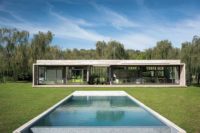The Lisbon-based brothers Manuel and Francisco Aires Mateus push their residential designs out of the realm of the ordinary toward the surreal and dreamlike. In one project, they arranged the living room furniture of a beach house on a floor of deep sand. In another, a renovated winery, they suspended the volumes of the bedrooms over the living space like geometric stalactites. And in this project for a young family outside the small city of Leiria, they created the perfect archetypal form of a house, straight out of a Monopoly game box or a fairy tale. An apparently solid volume wrapped completely in white plaster 'pitched roof and all' sits on the green plinth of an extended lawn, sharply profiled under the Portuguese sun.
But the visitor soon discovers that the actual living quarters spill out from this milk-carton house on all sides, while the interior opens to the light and air. A single deep opening in the front of the building reveals living spaces nestled around a diagonal void that cuts through the heart of the residence, extending in steps three stories from the roof to below grade. Adjacent to each of the house's four corners, the architects cut a small courtyard into the lawn, bringing daylight to underground bedrooms and creating a floor extending beyond the walls of the house like an invisible root system.
Additional Content:
Jump to credits & specifications
Manuel, who led the Lisbon-based design team on this project, explains that he developed the design around three considerations. First, the 'not so nice' site encouraged him to create an inward-looking building. The house is located in the center of a hilltop settlement outside the city that, as is often the case in Portugal, mixes the unruly charm of its rural origins with a motley collection of modest new residential buildings. Second, a distant view of Leiria's chief landmark, a medieval castle on a hilltop several kilometers to the west, provided an orientation for the central opening of the house, establishing a 'magical connection' between them. And lastly, he felt that the scale of the project, with four bedrooms and 3,200 square feet, was too big for the site. So he used the grade change between the street and the garden to put a large part of the program underground. 'Every space has its courtyard,' he points out. 'If you're in a bedroom, you have the privacy that a sunken court provides.' A garage and street-level entry open directly to the lower level, while a garden gate and stair bring visitors up to the lawn entrance.
The main event in the design is the three-story void above the central patio. This intriguing element 'takes the form drawn by the light,' Manuel explains. By alternating glazed, floor-to-ceiling openings and solid walls around this void, the architect emphasized the sculptural quality of the cut, carefully shaping the negative space as it descends from the south-facing roof opening. On the main level, an outdoor deck made of saw-cut granite planks faces the view and overlooks a square opening to the patio on the lower level, which is adorned by a potted lemon tree.
In one of the design's several quirks ' places where the architects allow the logic of form to trump functional convenience ' the deck is separated from the living area level by an uncomfortably large step, making a fluid link with indoor/outdoor living awkward. This is a consequence, it turns out, of the architects' effort to hide the edge of the floor slab behind a floor-to-ceiling sheet of glass bridging the lower level of the void on its north side, a strategy that affects areas around the patio in a too-scrupulous respect for precision. In addition, the large size of the patio cuts into the living spaces. There is no room for armchairs or a coffee table around the long sofa, which looks out to the castle on one end and at a wall cabinet hiding the television on the other.
Manuel explains that the unconventional roof finish of painted plaster was made possible by modern waterproofing systems, and says it will require no more maintenance than the stucco-finished concrete walls ' just periodic painting. For a 'real problem,' he points to the unprotected courtyards cut out of the lawn, especially since the couple has a young child. He is planning to install a nearly invisible safety net over the openings. How about a glass balustrade or a hedge? 'That would be horrible!' he replies.
The house is well crafted throughout, with elegant window frames of solid aluminum made in Switzerland, floors and stairs of local pine in wide strips up to 8 feet long, lacquered built-in closets and cabinets, and bathroom floors of Lioz, a rare Portuguese limestone. The client is building the architect's custom-designed furniture as funds become available. A handsome dining table and the long sofa are in place, but for now the couple's mattress rests on their bedroom floor.
The Aires Mateus brothers graduated from the Lisbon School of Architecture in the late 1980s, and apprenticed with Gon'alo Byrne. With its hidden, excavated spaces and labyrinthine plans, the Leiria house brings to mind the Casa Das Mudas Museum in Madeira by Paulo David, another Byrne disciple [RECORD, May 2007, page 192]. And in its mixture of archetype and sculptural form, it distills the spirit of Aldo Rossi's evocative visions with a fine, minimalist precision.
PeopleClient: Private
Architect: Aires Mateus & Associates Personnel in architect's firm who should receive special credit: Collaborators:
Photographer: SG+FG
Gross square footage: 3,200 sq. ft
Construction date: 2010 |
ProductsStructural system Stone Walls: Pedras Bellas Artes
Doors Wood Frame And Doors: Plancus Engenharia
Furnishings Cabinetwork And Custom Woodwork: Brumol Armchairs And Table: Carlos Motta Mole Armchairs: Sergio Rodrigues
Lighting Hanging Lamps: Tom Dixon Lighting: Lumini |


















